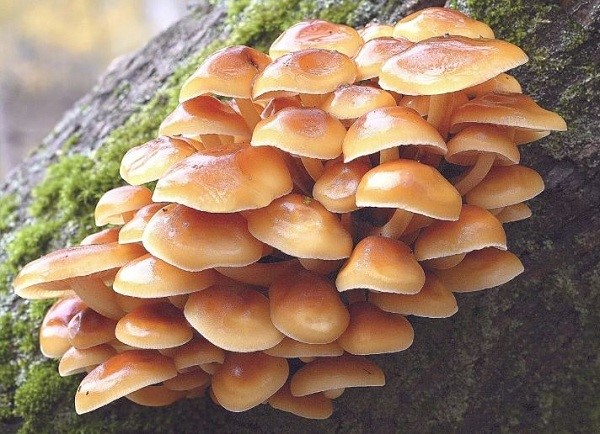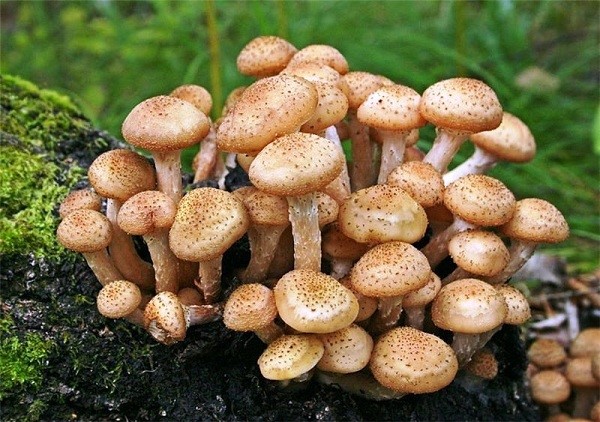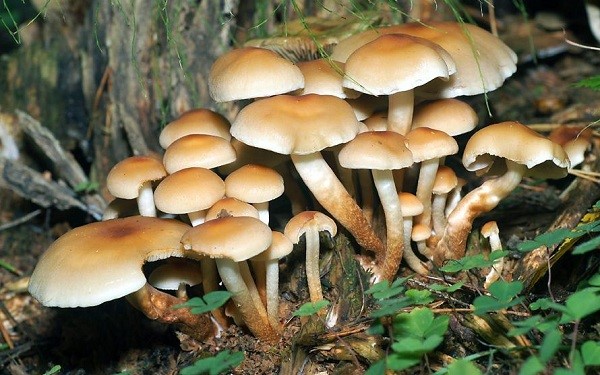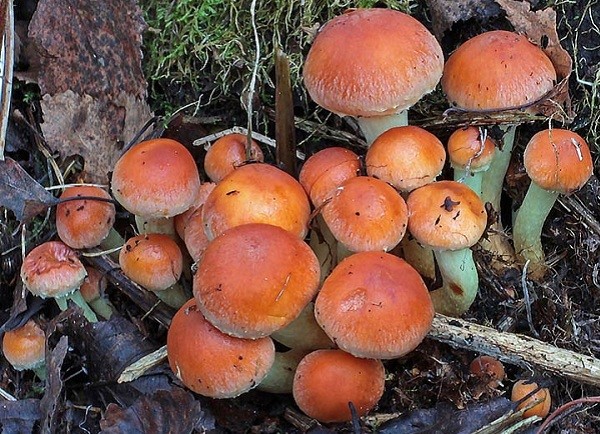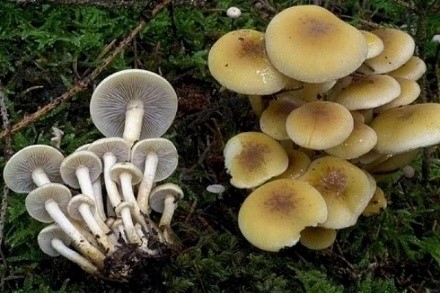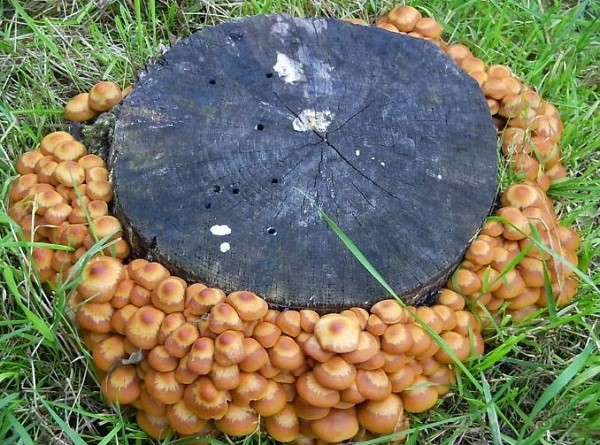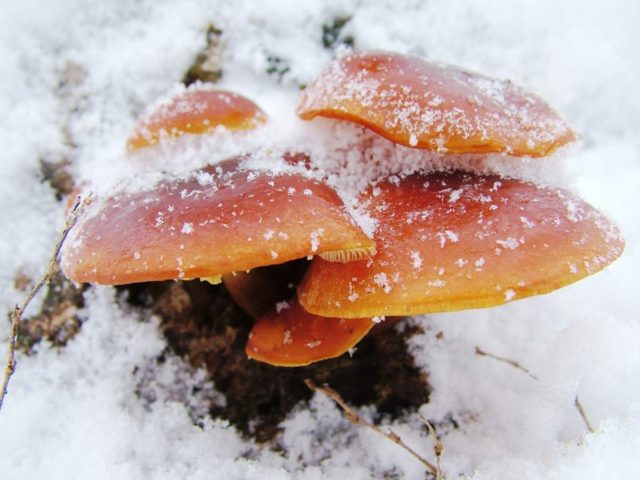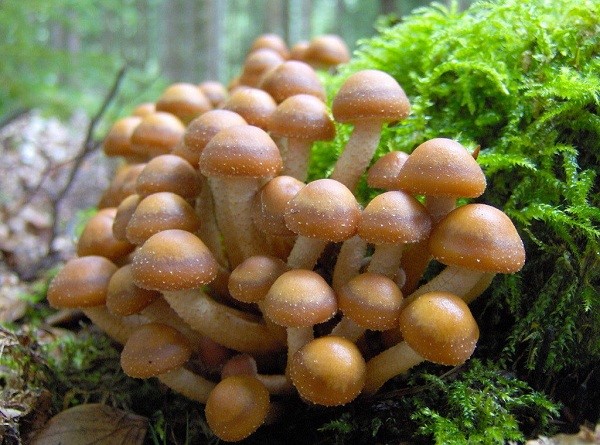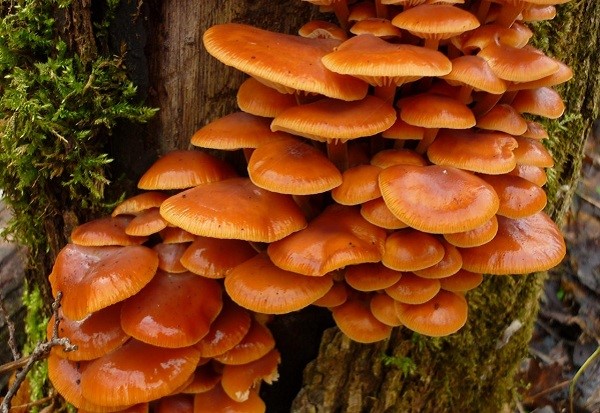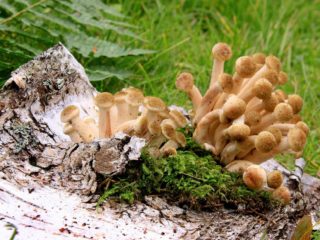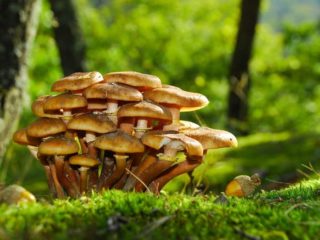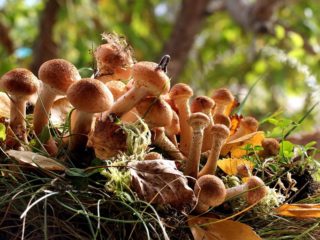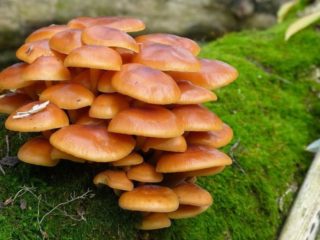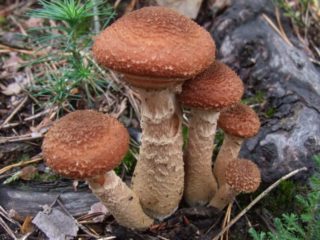Content
- 1 What trees do mushrooms grow on
- 2 What does hemp mushrooms look like?
- 3 Photo and description of hemp honey agarics
- 4 Why honey mushrooms settle on stumps
- 5 How honey mushrooms begin to grow on a tree stump
- 6 How many days do hemp mushrooms grow
- 7 Where to collect hemp mushrooms
- 8 When to collect hemp mushrooms
- 9 Conclusion
Hemp mushrooms have many varieties and forms of growth. The most famous and very useful of them are honey mushrooms on stumps. The multiple reasons for their popularity among amateurs and professional mushroom pickers include the rare taste that only this mushroom possesses, and the ease of harvesting, because it grows in multiple colonies around the stumps. According to most professional chefs, any mushroom is edible, but this is not entirely true.
What trees do mushrooms grow on
Regardless of edibility and growing season, hemp mushrooms appear on both dead and living trees. In particular, they thrive on rotten or damaged wood. However, mountainous regions are characterized by the appearance of honey agarics on conifers: spruce, cedar, pine and larch. Such mushrooms are distinguished when tasting by their bitter aftertaste and dark-colored stem, which does not affect their nutritional value in any way. Summer varieties from forest areas grow up to 7 cm in height with a 1 cm diameter of the leg. Usually the leg has a steep velum and is covered with small scales.
Photos of honey agarics on trees that have suffered a disease, mechanical damage:
What does hemp mushrooms look like?
Such mushrooms are difficult to confuse with other mycelium, because they have characteristic distinctive features. Poisonous analogues are also distinguished according to some characteristics, so it is almost impossible to get poisoned by mushrooms. It is worth noting that inedible hemp mushrooms are determined by a low level of toxicity, which makes them dangerous with a low degree of poisoning. Basically, autumn honey fungus parasitizes trees and affects over 200 species per year. Fungus colonies can be recognized by the ringed growth around the stump. Single specimens are extremely rare.
Autumn honey agaric grows for only a few months on the stumps of felled birch trees. He received several names among the people: autumn, real honey mushroom, Uspensky mushroom. Occurs on boggy birch forests, where there are a lot of rotten trees and stumps. In coniferous areas, honey agarics are rare, although you can find their clusters near an old spruce. Winter hemp mycelium grows at the base of any felled tree on the north side, in swampy areas.
Photo and description of hemp honey agarics
Like any forest mushroom, honey agaric has several false counterparts that need to be able to be identified by their appearance. With this knowledge, the risk of poisoning with the harvested crop is eliminated. Each species grows under certain weather conditions. Also, external characteristics have their own characteristics, which does not allow confusing an edible mushroom with a poisonous one.
False hemp mushrooms
Preferably inedible honey mushrooms grow on rotten stumps that have been affected by root rot, cancer, or earth insects during life. In appearance, the fruiting body can be distinguished by a bright cap, which has a delicate pinkish or yellowish brown tint. The most dangerous are always bright brown or orange, with the exception of the color is sulfur-yellow honey agaric. The surface of the cap is smooth, without scales. The mushroom is slippery to the touch, stickiness appears after rain. Under the cap, no steep velum is observed, the spore plates quickly acquire a dirty olive, green or blue tint.Mushroom pickers advise you to first feel the aroma of the mycelium, and if there is a smell of earth, mold, then the mycelium is poisonous. These include:
- Poppy False Foam... It looks and tastes like a summer mushroom. It can be recognized by the bright orange stem, which turns yellow closer to the cap. The height of the mycelium reaches 8-10 cm, gray plates grow to the stem.
- Brick red... It is considered conditionally edible; it tastes very bitter when tasting. The hat is large with a reddish-brown color, it grows up to 10 cm in diameter. When cut, the stem of the mushroom is hollow.
- Sulfur yellow... A mushroom with a small pale yellow cap and a high stem - 10-12 cm. It has a pungent and unpleasant odor. Grows in numerous colonies on forest stumps. Young mycelium grows in the form of a bell.
Edible hemp mushrooms
By their nature, honey agarics feed on the remains of stumps that have not been infected with a serious disease. Edible mycelium is characterized by its appearance - a thin leg with a ring of film from the middle of the mushroom. The color of the honeydew pulp depends on the area where the stump grows. Colonies growing near poplar have a copper-yellow hue, in stumps of conifers they are reddish or brown, in oak or elderberries they are brown or gray. Healthy plates are always creamy or yellowish-white. Mushrooms are endowed with a subtle clove aroma and a sweet and sour aftertaste. They grow in the same forests as inedible counterparts, they can cohabit on stumps in the neighborhood, which does not affect the quality of real mushrooms.
Harmless mushrooms are usually called autumn, winter, summer and meadow varieties of mycelium. The former have a characteristic and memorable cap, the surface of which is covered with small scales. The fruit body has a pleasant mushroom aroma, the consistency of the leg is light yellow, fibrous. The autumn season of hemp honey agarics begins in late August and lasts until mid-October. Summer and meadows are very similar in appearance: a medium-sized mycelium with a cap diameter of 5 cm and a leg height of up to 10 cm, are found in meadows and in the forest. The only difference: meadows do not grow on stumps, their family appears in a circle in small clusters.
A bright representative of winter mushrooms appears with the beginning of the winter thaw on old stumps of poplars or willows. The mushroom legs are hollow, velvety to the touch. The fruiting body grows up to 8 cm in height and 3-4 cm in diameter. The hat with a glossy sheen has an ocher-brown color. The leg is hollow, the pulp is not bitter, it gives off a pleasant smell. The spore plates are always light brown or cream in color.
Why honey mushrooms settle on stumps
Since mushrooms belong to the class of parasitic fungi, it is logical to assume that a stump affected by the disease is a favorable habitat for them. The mushrooms found on the tree trunk characterize the presence of an infection that has already penetrated deep into the trunk. The mycelium does not grow immediately, but with its appearance accelerated destruction of wood occurs. First, saprophytes develop, then basidal fruiting bodies appear. They transform the habitat from acidic to alkaline, after which hat mushrooms grow and the tree completely loses its shape. Therefore, honey agaric mushrooms grow on a hemp for only a few years, then the habitat loses its value. Also, the stump of a dead tree is rich in cellulose, which the mycelium feeds on. This type of parasitic fungi can be called a forest orderly, because thanks to their growth and reproduction, young trees remain healthy.
How honey mushrooms begin to grow on a tree stump
When a tree receives mechanical damage or becomes infected with a disease, a gradual process of dying off of the bark and other parts of the trunk begins. Each type of mushroom has its own preferences for habitat.False fungus develops only on coniferous deadwood, edible specimens can be found almost anywhere in a certain season. The growth of the mycelium begins when the spores enter the site of injury. Next comes the development of imperfect microorganisms that feed on residual living cells. They then progress to the basidal mycelium. The habitat is acidified, intermediate decay products go into food. As soon as the cellulose reserves are running out, other types of parasitic fungi appear, which break down protein and fiber. At the stage of loss of shape and integrity, the tree becomes rotten, overgrown with moss and other microorganisms, which ultimately leads to the beginning of honey agaric development. They mineralize organic cells, thereby surviving on the dead stump.
How many days do hemp mushrooms grow
The growth of the mycelium and its rate depend on factors such as the temperature of the habitat, humidity, and the presence of beneficial organisms. Favorable air temperature for the germination of fruit bodies is from + 14 to + 25 ° С. It should be noted that this is a suitable climate for meadow mushrooms. For varieties of autumn, winter and spring honey agarics that grow on stumps, + 3 ° C is enough to start the development of spores. Under such conditions, fruiting bodies germinate in 2-3 days. If the temperature reaches + 28 ° C, then the processes stop. When there is good soil moisture in the range of 50-60% and an acceptable temperature, the mushrooms actively grow, bear fruit several times per season. The foot tempo can stop for 24 hours if worms or insects are present in the soil. Full ripening occurs on the 5-6th day.
After the autumn rain, after the honey agarics, you can move forward for 2-3 days. It is also worth considering the September and October fogs. After their retreat, an increase in the yield on the stumps can be seen. Autumn species can be found in November if the temperature was above zero. Here, moisture is the catalyst for growth, which is often lacking in mushrooms. As for the winter varieties, they can delay growth at the time of frost and continue it when the air temperature reaches 0 or + 7 ° C.
Where to collect hemp mushrooms
On the territory of Russia, there are many climatic zones where you can find colonies of mycelium of any variety. Again, the arrangement of families depends on convenience and favorable conditions. Autumn species grow on coniferous wood, fallen trees, and are common in completely coniferous and mixed forests. Summer and spring hemp mushrooms mainly grow in deciduous forests. They are often found on tree trunks: oak, birch, acacia, poplar, ash or maple. Winter mushrooms prefer oak stumps, on which it is beneficial to reproduce due to the nutritional value of wood.
When to collect hemp mushrooms
The harvest season depends on the climatic factor in a particular area. You can go hunting for spring mushrooms from April to May. Along with edible specimens, you can find false mushrooms growing on trees that look like honey agarics. The summer harvest falls in July and August. Then autumn species begin to grow actively, from about the end of August to the beginning of November. Winter ones are rare, but if you go in search of mycelium in November or December, you can collect 1-2 layers of fruit bodies.
Conclusion
Honey mushrooms on stumps are found more often than other, more valuable varieties. They have a memorable aroma and appearance, so it is almost impossible to confuse them with poisonous counterparts. Mushrooms are rich in vitamins and macronutrients that are rarely found in such quantities in nature's products. It is worth remembering that without the knowledge of false counterparts, the mushroom picker must be careful to conduct a quiet hunt.
